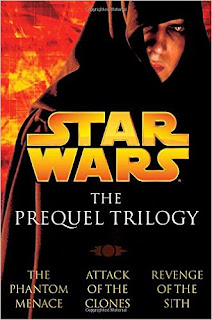Book Review: 'Star Wars: The Prequel Trilogy' novelization omnibus
Star Wars film novelizations have been around since late 1976, when Del Rey Books published Alan Dean Foster’s Star Wars: From the Adventures of Luke Skywalker. Credited to writer-director George Lucas, the first adaptation of a Star Wars screenplay gave the world its first glimpse at a story set “a long time ago in a galaxy far, far away.”
The book’s 1976 edition performed modestly at first; later, when Star Wars became a box office juggernaut, sales of the paperback edition of Foster’s novelization took off like an X-wing fighter and launched it into the New York Times Best-Sellers list.
Since then, Del Rey, a division of Ballantine Books, has published all the subsequent Star Wars novelizations, including the ones for the 1999-2005 Star Wars Prequel Trilogy.
For the first time in one stunning volume, here is the complete, epic story arc: The Phantom Menace, Attack of the Clones, and Revenge of the Sith. Experience the sweeping tale of good and evil, of myth and magic, of innocence and power–and witness the tragic transformation of Anakin Skywalker from mere slave to one of the greatest, most powerful, and feared villains of the galaxy: Darth Vader.
“The path has been placed before you, Anakin.
The choice to take it must be yours alone.” - Publisher’s blurb, Star Wars: The Prequel Trilogy
Just as 20th Century Fox and Lucasfilm have issued (and reissued) the Star Wars movies in standalone DVD and Blu-ray editions and box sets, Ballantine has published the novels by Terry Brooks, R.A. Salvatore, and Matthew Stover in single volumes and in an omnibus edition: Star Wars: The Prequel Trilogy.
Published in 2007 to coincide with Star Wars’ 30th Anniversary, this 1008-page collection consists of:
- Star Wars - Episode I: The Phantom Menace, by Terry Brooks (1999)
- Star Wars - Episode II: Attack of the Clones, by R.A. Salvatore (2002)
- Star Wars - Episode III: Revenge of the Sith, by Matthew Stover (2005)
My Take
All three novels are based on the screenplays by George Lucas and (in the case of Attack of the Clones, Lucas and Jonathan Hales), so they follow the plot of the movies closely. However, the three authors, who worked from early versions of the scripts, include details and scenes not seen in the movies.
In The Phantom Menace, Terry Brooks (The Sword of Shannara) added three chapters of original material set on Tatooine shortly before the events of the film. These chapters describe Anakin Skywalker’s next-to-the-last Podrace (which was alluded to in Lucas’s movie version) and his precocious desire to become a space pilot. Brooks, who talked with Star Wars’ creator about the plots for Episodes II and III in a two-hour interview before he began to write the novel, also included a scene in which Anakin rescues a wounded Tusken Raider in the Tatooine desert. Lucas also gave Brooks the backstory of the Sith Order, Darth Bane, and the Sith’s Rule of Two, which stipulates that there can only be two Sith Lords at one time, a master and an apprentice.
R.A. Salvatore’s 2002 novelization of the Hales-Lucas screenplay for Attack of the Clones follows the pattern established by Brooks in the previous novelization. It adds more depth and details to the material derived from the film, includes scenes that were filmed but later deleted, and adds several chapters created exclusively for the novel. As in The Phantom Menace, Salvatore’s version begins with several chapters set before the movie’s start. including Anakin Skywalker’s nightmare about his mother and scenes that depict Senator Padme Amidala’s relationship with her family on Naboo.
Matthew Stover’s adaptation of Star Wars - Episode III: Revenge of the Sith sticks closer to the chronology of Lucas’s film version. It starts with an extended account of the Battle of Coruscant and, in sharp contrast to the other Star Wars novelizations, draws on various Expanded Universe/Legends works, including James Luceno’s novel Labyrinth of Evil and the 2003-2005 Star Wars: Clone Wars 2D-animated TV series.
Stover, who also wrote Star Wars: Shatterpoint, adds more details to such characters as Count Dooku, Gen. Grievous, Obi-Wan Kenobi, Padme Amidala, and especially Anakin Skywalker. The novel gives readers more insights into Anakin’s troubled personality and his true motives for wanting to become a Jedi Master - motives that are exploited by Darth Sidious and hasten Skywalker’s tragic transition to Darth Vader.
Although each writer has a unique writing style, all three novels are like tiles in a literary mosaic.They work well as individual stories, each with its own set of exciting and suspenseful situations yet they combine to tell a bigger, deeper tale of heroes, villains, and the struggle between the forces of good and evil,
To some Star Wars fans, the New York Times bestselling adaptations are better than Lucas’s films because they focus more on character development and motivations.
This, of course, is the advantage that books have over movies, particularly if they are well-written. The Star Wars movies, on average, have only two hours in which to tell their stories, and many scenes that delve into characters and motivations are often deleted or not filmed at all.
Books, on the other hand, are not limited by such constraints as running time or the expenses of special effects sequences and on-location film shoots. The medium of the written word allows Brooks, Salvatore, and Stover to go further into Lucas’s characters and situations and give readers a richer version of the Tragedy of Darth Vader.


.jpg)

Comments
Post a Comment